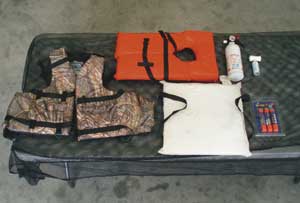
The Causeway holds a few fish this time of year, but the action’s far better at the mouth of the Tchefuncte River.
Before you jump into your boat and head out on the water, you may want to spend a few minutes checking out your safety equipment to be sure everything is in proper working order. No one wants to have a boating accident, but if one should happen, safety gear could spell the difference between a safe return home or a tragedy.
You can start with the most-important piece of safety equipment on your boat, the personal flotation device, or PFD. You should check each life vest on your boat to be sure it is in good condition. A life vest that has broken straps or has tears in the fabric is not acceptable as a PFD, and you could be ticketed for not having the proper number of life vests on board your boat.
Everyone knows that you are supposed to have one PFD for each person on board your boat, but did you also know that the PFD must be the proper size for the person who will be wearing it? In other words, an adult life vest is not acceptable for use on a child.
Did you also know that children are required by law to wear PFDs whenever the boat is under way? It would be a good example for the youngsters if everyone onboard were to wear a PFD.
Other safety devices you should be carrying on your boat include a throw cushion or ring, a fire extinguisher, a sound-producing device, navigation lights and visual distress signals. Not all of these items are required on all vessels, but every one of them could be valuable in case of an emergency.
The cushion or ring would be used to throw to someone who may have fallen overboard. The sound-producing device could be as simple as a hand-held whistle, or it may be an electric horn mounted on the boat.
Navigation lights are required on all boats that will be operating between sundown and sunup. Most boats are equipped with navigation lights, so be sure to include checking your navigation lights as part of your regular maintenance procedures. If you have the plug-in type light sockets for your navigation lights, you may want to spray those sockets with an anti-corrosion lubricant to keep the lights working properly.
Next check your fire extinguisher to be sure that it is fully charged. If the gauge indicates that the extinguisher is discharged, it should be replaced immediately.
Visual distress signals are not required by law on all boats or in all waterways, but I wouldn’t want to be boating without them. Flares come with an expiration date on them. Once the date has expired, the flare is no longer acceptable as a visual distress, and if your boat is required to carry flares, you could be ticketed for not having proper signaling devices onboard.
Now that you have checked all of your required safety equipment, you may want to consider some optional equipment. Accessories such as a depth finder to help you avoid running aground and a GPS to help keep you from getting lost can be very valuable for today’s boater.
Cell phones can sometimes be used to call for help, but not all cell phones will work out on the water. A good VHF radio would be a great backup for the cell phone in case of an emergency. One of the newer features of the VHF radio is the ability to link up with the GPS so that in an emergency you can push one button and the VHF will send out a distress signal complete with the GPS coordinates of your location.
Don’t forget about the basics such as your bilge pump. I have seen many boats that have bilge-pump failures due to trash being sucked into the pump, which causes it to clog up and usually shorts out the electric motor. Before you head out to the boat launch, check your bilge pump to be sure it is working, and while you are there, take a little time to clean out the bilge of any mud or debris that may damage your pump. If your boat is not equipped with a bilge pump, make sure you carry some sort of bailing bucket on board at all times.
Although not a required item, you may want to consider equipping your boat with a good first aid kit. You never know when someone may get a cut or possibly stuck with a fish hook. A good first aid kit will be much appreciated in a situation like this.
Remember to be prepared and keep a stock of drinking water and possibly some non-perishable food items on board in case you do become stranded. Other items to keep on board would be sunscreen and bug repellent.
If you have any questions about the required safety gear for your boat, contact the U.S. Coast Guard Auxiliary or the US Power Squadron in your area. Both organizations can supply you with pamphlets that will outline all of the required safety gear for your boat or, if you want, they will give your boat a free safety check. The best part of this free safety check is there are no tickets or citations for not passing the check. They simply give you a list of items that you will need to pass the check.
Once you have made whatever corrections or additions are needed, you can have your boat re-examined, and you will be issued a window decal to show that your boat has passed the safety check. Remember, be prepared for any unforeseen emergency, and always put safety first.
Have a safe and happy boating summer. Maybe we will meet on the water someday.


